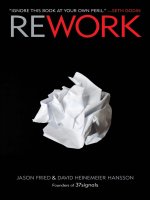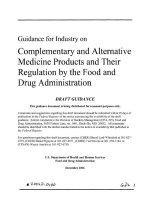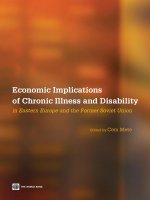Engineering economic 14th by william sullivan and koeling ch 05
Bạn đang xem bản rút gọn của tài liệu. Xem và tải ngay bản đầy đủ của tài liệu tại đây (246.73 KB, 32 trang )
Engineering Economy
Chapter 5: Evaluating a Single
Project
Engineering Economy, Sixteenth Edition
By William G. Sullivan, Elin M. Wicks, and C. Patrick Koelling
Copyright ©2015 by Pearson Education, Inc.
Upper Saddle River, New Jersey 07458
All rights reserved.
The objective of Chapter 5 is to
discuss and critique
contemporary methods for
determining project
profitability.
Engineering Economy, Sixteenth Edition
By William G. Sullivan, Elin M. Wicks, and C. Patrick Koelling
Copyright ©2015 by Pearson Education, Inc.
Upper Saddle River, New Jersey 07458
All rights reserved.
Proposed capital projects can be
evaluated in several ways.
• Present worth (PW)
• Future worth (FW)
• Annual worth (AW)
• Internal rate of return (IRR)
• External rate of return (ERR)
• Payback period (generally not appropriate as a primary
decision rule)
Engineering Economy, Sixteenth Edition
By William G. Sullivan, Elin M. Wicks, and C. Patrick Koelling
Copyright ©2015 by Pearson Education, Inc.
Upper Saddle River, New Jersey 07458
All rights reserved.
To be attractive, a capital project
must provide a return that exceeds
a minimum level established by
the organization. This minimum
level is reflected in a firm’s
Minimum Attractive Rate of
Return (MARR).
Engineering Economy, Sixteenth Edition
By William G. Sullivan, Elin M. Wicks, and C. Patrick Koelling
Copyright ©2015 by Pearson Education, Inc.
Upper Saddle River, New Jersey 07458
All rights reserved.
Many elements contribute to
determining the MARR.
• Amount, source, and cost of money available
• Number and purpose of good projects available
• Perceived risk of investment opportunities
• Type of organization
Engineering Economy, Sixteenth Edition
By William G. Sullivan, Elin M. Wicks, and C. Patrick Koelling
Copyright ©2015 by Pearson Education, Inc.
Upper Saddle River, New Jersey 07458
All rights reserved.
The most-used method is the
present worth method.
The present worth (PW) is found by
discounting all cash inflows and outflows to
the present time at an interest rate that is
generally the MARR.
A positive PW for an investment project
means that the project is acceptable (it
satisfies the MARR).
Engineering Economy, Sixteenth Edition
By William G. Sullivan, Elin M. Wicks, and C. Patrick Koelling
Copyright ©2015 by Pearson Education, Inc.
Upper Saddle River, New Jersey 07458
All rights reserved.
Present Worth Example
Consider a project that has an initial
investment of $50,000 and that returns
$18,000 per year for the next four years. If
the MARR is 12%, is this a good
investment?
PW = -50,000 + 18,000 (P/A, 12%, 4)
PW = -50,000 + 18,000 (3.0373)
PW = $4,671.40 This is a good investment!
Engineering Economy, Sixteenth Edition
By William G. Sullivan, Elin M. Wicks, and C. Patrick Koelling
Copyright ©2015 by Pearson Education, Inc.
Upper Saddle River, New Jersey 07458
All rights reserved.
Bond value is a good example of
present worth.
The commercial value of a bond is the PW of
all future net cash flows expected to be
received--the period dividend [face value (Z)
times the bond rate (r)], and the redemption
price (C), all discounted to the present at the
bond’s yield rate, i%.
VN=C (P/F, i%, N) + rZ (P/A, i%, N)
Engineering Economy, Sixteenth Edition
By William G. Sullivan, Elin M. Wicks, and C. Patrick Koelling
Copyright ©2015 by Pearson Education, Inc.
Upper Saddle River, New Jersey 07458
All rights reserved.
Bond example
What is the value of a 6%, 10-year bond with a
par (and redemption) value of $20,000 that pays
dividends semi-annually, if the purchaser
wishes to earn an 8% return?
VN = $20,000 (P/F, 4%, 20) + (0.03)$20,000 (P/A, 4%, 20)
VN = $20,000 (0.4564) + (0.03)$20,000 (13.5903)
VN = $17,282.18
Engineering Economy, Sixteenth Edition
By William G. Sullivan, Elin M. Wicks, and C. Patrick Koelling
Copyright ©2015 by Pearson Education, Inc.
Upper Saddle River, New Jersey 07458
All rights reserved.
Pause and solve
Bill Mitselfik wants to buy a bond. It has a face value of
$50,000, a bond rate of 6% (nominal), payable semiannually, and matures in 10 years. Bill wants to earn a
nominal interest of 8%. How much should Bill pay for the
bond?
Engineering Economy, Sixteenth Edition
By William G. Sullivan, Elin M. Wicks, and C. Patrick Koelling
Copyright ©2015 by Pearson Education, Inc.
Upper Saddle River, New Jersey 07458
All rights reserved.
Solution
Bond value equation
where
Engineering Economy, Sixteenth Edition
By William G. Sullivan, Elin M. Wicks, and C. Patrick Koelling
Copyright ©2015 by Pearson Education, Inc.
Upper Saddle River, New Jersey 07458
All rights reserved.
Capitalized worth is a special
variation of present worth.
• Capitalized worth is the present worth of all revenues or
expenses over an infinite length of time.
• If only expenses are considered this is sometimes referred
to as capitalized cost.
• The capitalized worth method is especially useful in
problems involving endowments and public projects with
indefinite lives.
Engineering Economy, Sixteenth Edition
By William G. Sullivan, Elin M. Wicks, and C. Patrick Koelling
Copyright ©2015 by Pearson Education, Inc.
Upper Saddle River, New Jersey 07458
All rights reserved.
The application of CW concepts.
The CW of a series of end-of-period
uniform payments A, with interest at i%
per period, is A(P/A, i%, N). As N
becomes very large (if the A are perpetual
payments), the (P/A) term approaches 1/i.
So, CW = A(1/i).
Engineering Economy, Sixteenth Edition
By William G. Sullivan, Elin M. Wicks, and C. Patrick Koelling
Copyright ©2015 by Pearson Education, Inc.
Upper Saddle River, New Jersey 07458
All rights reserved.
Pause and solve
Betty has decided to donate some funds to her local
community college. Betty would like to fund an endowment
that will provide a scholarship of $25,000 each year in
perpetuity, and also a special award, “Student of the
Decade,” each ten years (again, in perpetuity) in the amount
of $50,000. How much money does Betty need to donate
today, in one lump sum, to fund the endowment? Assume
the fund will earn a return of 8% per year.
Engineering Economy, Sixteenth Edition
By William G. Sullivan, Elin M. Wicks, and C. Patrick Koelling
Copyright ©2015 by Pearson Education, Inc.
Upper Saddle River, New Jersey 07458
All rights reserved.
Solution
First, convert “Student of the Decade” funds into an
equivalent annual amount over the ten years.
We can add this to the annual scholarship and then use
capitalized worth to bring it all back to time zero.
Engineering Economy, Sixteenth Edition
By William G. Sullivan, Elin M. Wicks, and C. Patrick Koelling
Copyright ©2015 by Pearson Education, Inc.
Upper Saddle River, New Jersey 07458
All rights reserved.
Future Worth (FW) method is an
alternative to the PW method.
• Looking at FW is appropriate since the primary objective
is to maximize the future wealth of owners of the firm.
• FW is based on the equivalent worth of all cash inflows
and outflows at the end of the study period at an interest
rate that is generally the MARR.
• Decisions made using FW and PW will be the same.
Engineering Economy, Sixteenth Edition
By William G. Sullivan, Elin M. Wicks, and C. Patrick Koelling
Copyright ©2015 by Pearson Education, Inc.
Upper Saddle River, New Jersey 07458
All rights reserved.
Future worth example.
A $45,000 investment in a new conveyor
system is projected to improve throughput and
increasing revenue by $14,000 per year for five
years. The conveyor will have an estimated
market value of $4,000 at the end of five years.
Using FW and a MARR of 12%, is this a good
investment?
FW = -$45,000(F/P, 12%, 5)+$14,000(F/A, 12%, 5)+$4,000
FW = -$45,000(1.7623)+$14,000(6.3528)+$4,000
FW = $13,635.70 This is a good investment!
Engineering Economy, Sixteenth Edition
By William G. Sullivan, Elin M. Wicks, and C. Patrick Koelling
Copyright ©2015 by Pearson Education, Inc.
Upper Saddle River, New Jersey 07458
All rights reserved.
Annual Worth (AW) is another
way to assess projects.
• Annual worth is an equal periodic series of dollar
amounts that is equivalent to the cash inflows and
outflows, at an interest rate that is generally the
MARR.
• The AW of a project is annual equivalent revenue
or savings minus annual equivalent expenses, less
its annual capital recovery (CR) amount.
Engineering Economy, Sixteenth Edition
By William G. Sullivan, Elin M. Wicks, and C. Patrick Koelling
Copyright ©2015 by Pearson Education, Inc.
Upper Saddle River, New Jersey 07458
All rights reserved.
Capital recovery reflects the capital cost
of the asset.
• CR is the annual equivalent cost of the capital invested.
• The CR covers the following items.
– Loss in value of the asset.
– Interest on invested capital (at the MARR).
• The CR distributes the initial cost (I) and the salvage value
(S) across the life of the asset.
Engineering Economy, Sixteenth Edition
By William G. Sullivan, Elin M. Wicks, and C. Patrick Koelling
Copyright ©2015 by Pearson Education, Inc.
Upper Saddle River, New Jersey 07458
All rights reserved.
A project requires an initial investment of $45,000,
has a salvage value of $12,000 after six years, incurs
annual expenses of $6,000, and provides an annual
revenue of $18,000. Using a MARR of 10%,
determine the AW of this project.
Since the AW is positive, it’s a good investment.
Engineering Economy, Sixteenth Edition
By William G. Sullivan, Elin M. Wicks, and C. Patrick Koelling
Copyright ©2015 by Pearson Education, Inc.
Upper Saddle River, New Jersey 07458
All rights reserved.
Internal Rate of Return
• The internal rate of return (IRR) method is the most
widely used rate of return method for performing
engineering economic analysis.
• It is also called the investor’s method, the discounted cash
flow method, and the profitability index.
• If the IRR for a project is greater than the MARR, then the
project is acceptable.
Engineering Economy, Sixteenth Edition
By William G. Sullivan, Elin M. Wicks, and C. Patrick Koelling
Copyright ©2015 by Pearson Education, Inc.
Upper Saddle River, New Jersey 07458
All rights reserved.
How the IRR works
• The IRR is the interest rate that equates the equivalent
worth of an alternative’s cash inflows (revenue, R) to the
equivalent worth of cash outflows (expenses, E).
• The IRR is sometimes referred to as the breakeven interest
rate.
The IRR is the interest i'% at which
Engineering Economy, Sixteenth Edition
By William G. Sullivan, Elin M. Wicks, and C. Patrick Koelling
Copyright ©2015 by Pearson Education, Inc.
Upper Saddle River, New Jersey 07458
All rights reserved.
Solving for the IRR is a bit more
complicated than PW, FW, or AW
• The method of solving for the i'% that equates revenues
and expenses normally involves trial-and-error
calculations, or solving numerically using mathematical
software.
• The use of spreadsheet software can greatly assist in
solving for the IRR. Excel uses the IRR(range, guess) or
RATE(nper, pmt, pv) functions.
Engineering Economy, Sixteenth Edition
By William G. Sullivan, Elin M. Wicks, and C. Patrick Koelling
Copyright ©2015 by Pearson Education, Inc.
Upper Saddle River, New Jersey 07458
All rights reserved.
Challenges in applying the IRR
method.
• It is computationally difficult without proper tools.
• In rare instances multiple rates of return can be found. (See
Appendix 5-A.)
• The IRR method must be carefully applied and interpreted
when comparing two more mutually exclusive alternatives
(e.g., do not directly compare internal rates of return).
Engineering Economy, Sixteenth Edition
By William G. Sullivan, Elin M. Wicks, and C. Patrick Koelling
Copyright ©2015 by Pearson Education, Inc.
Upper Saddle River, New Jersey 07458
All rights reserved.
Reinvesting revenue—the
External Rate of Return (ERR)
• The IRR assumes revenues generated are reinvested at
the IRR—which may not be an accurate situation.
• The ERR takes into account the interest rate, ε,
external to a project at which net cash flows generated
(or required) by a project over its life can be
reinvested (or borrowed). This is usually the MARR.
• If the ERR happens to equal the project’s IRR, then
using the ERR and IRR produce identical results.
Engineering Economy, Sixteenth Edition
By William G. Sullivan, Elin M. Wicks, and C. Patrick Koelling
Copyright ©2015 by Pearson Education, Inc.
Upper Saddle River, New Jersey 07458
All rights reserved.









